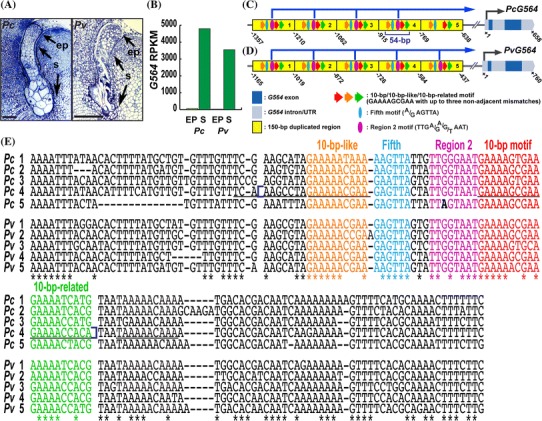Fig. 5.

The G564 gene and mRNA abundance in Scarlet Runner Bean and Common Bean. a Plastic section of Scarlet Runner Bean [Phaseolus coccineus (Pc)] globular-stage embryo and paraffin section of Common Bean [Phaseolus vulgaris (Pv)] globular-stage embryo. b Scarlet Runner Bean and Common Bean G564 mRNA prevalences determined by RNA-Seq analysis of laser-captured globular-stage embryo proper and suspensor regions. c and d Conceptual representations of the G564 gene and upstream region in Scarlet Runner Bean (c) and Common Bean (d). Dark blue boxes represent exons. Light blue boxes represent introns and UTRs. Yellow boxes represent 150-bp tandem repeats in the upstream region (Weterings et al. 2001; Kawashima et al. 2009). Red, orange, and green arrows; purple ovals; and blue ovals indicate the 10-bp, 10-bp-like and 10-bp-related motifs; Region 2 motif; and Fifth motif, respectively. Dark blue bracket designates the 54-bp region that was analyzed in this study. Numbers indicate positions relative to the transcription start site (+1). e Nucleotide sequence alignment of the five G564 150-bp tandem repeats. Nucleotides conserved across all five G564 150-bp repeats from Scarlet Runner Bean and Common Bean are indicated by asterisks. The 10-bp, 10-bp-like and 10-bp-related motifs, Region 2 motif and Fifth motif are shown in red, orange, green, purple and blue font, respectively. The bold A in the PcG564 fifth 150-bp repeat is a natural mutation that makes the Region 2 motif non-functional (Kawashima et al. 2009). Sequences shown to function as the 10-bp motif are underlined (Kawashima et al. 2009). The number to the left of the aligned sequences indicates the position of each 150-bp repeat. Gaps were introduced for optimal alignment. ep, embryo proper; Pc, Phaseolus coccineus; Pv, Phaseolus vulgaris; RPKM, reads per kilobase per million; s, suspensor
